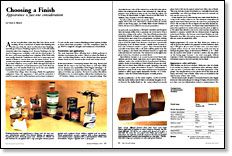
Synopsis: Finishing chemist Chris A. Minick considers three things when choosing a finish: the application equipment he has, the appearance he wants, and the degree of protection the project needs. He divides finishes into three general classes depending on their penetration, and he discusses color and luster. He addresses different finish protection levels, and he includes side information on nontoxic finishes. Photo comparisons show varying translucent finishes, and an accompanying chart allows you to select the best finish for your project in terms of surface penetration, stain and moisture resistance, color, luster, ease of repair, and dry time.
Ask ten woodworkers what they like best about woodworking. I’ll bet a truck-load of walnut that finishing isn’t at the top of the list. Most woodworkers hate finishing— and with good reason. Finishing requires you to work with stinky chemicals rather than shaping wood. Because finishing is the last step in a long process, a mistake could ruin the whole project. Or the error could mean spending hours stripping off the finish with more smelly chemicals. Furthermore, there are so many types and brands of finish to choose from (see the photo below). It’s no wonder why many woodworkers get accustomed to applying only one kind of finish to every project. While that approach may be efficient, it could lead to a visual sameness to your work. More importantly, your old standby finish may not be the most suitable treatment for your project’s intended use.
I consider three things when choosing a finish: the application equipment I have, the appearance I want and the protection I need for a project (such as film hardness and moisture resistance). To sort out the most common finishing-product options, it helps to know about their properties. I use the comparison chart on pp. 86-87 to weigh the strengths and weaknesses of each finish.
Penetration and application
The most important factor affecting how a finish performs is whether it penetrates the surface. Based on where the finish resides, woodworking finishes can be divided into three general classes: “in the wood,” “in and on the wood” and “on the wood.”
In-the-wood finishes—Penetrating finishes like tung, linseed and Danish oils are easy to use. Just wipe them on, and wipe off the excess. Because easy repairability is their biggest advantage, I often use oil finishes on projects that take abuse. A periodic reapplication of oil hides any scratches. The lack of a surface film allows oil finishes to be re-coated anytime without fear of adhesion loss.
Oil finishes darken wood but leave it natural-looking.
From Fine Woodworking #104
Fine Woodworking Recommended Products

Sawstop Miter Gauge


Dividers





















Log in or create an account to post a comment.
Sign up Log in